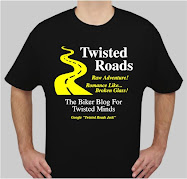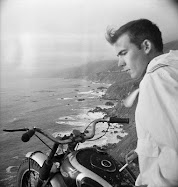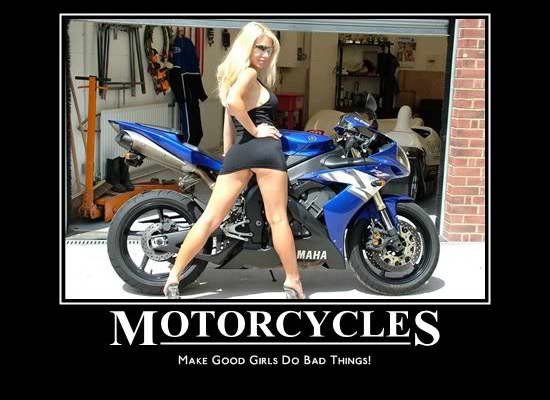Melissa Holbrook Pierson
(W.W. Norton and Company, 240 pages, $15.95)
My rating: 5 Stars (out of 5)
There is a strong possibility that Melissa Holbrook Pierson’s work, “The Perfect Vehicle, What Is It About Motorcycles,” may also be the most perfect book on motorcycling. It is complex in content and delivers a sophisticated message that will not appeal to all. Yet there is a rare intimacy in its complexity that makes a certain kind of reader/rider feel as if they are party to a private conversation. The 240-page work is part history and part diary; part editorial and part ride report; part love story and part Greek tragedy (in which one character is left standing, surrounded by heartbreak but definitely wiser -- a number of times).

Melissa Holbrook Pierson
photo by Jenna Knudsen Brantmeye
The author easily shifts from one category to the next as if she was changing gears while maneuvering her venerable 1987 Moto Guzzi Lario. In the first chapter, she deals with definitions through the artful presentation of background material, starting with herself. Well-educated, articulate, and refined, Pierson references Mrs. King’s ballroom dancing school, graduate school, “Sir Gawain and the Green Knight,” and William F. Buckley, Jr. in the first three paragraphs. The references are incidental in telling us who she is, where she came from, and how she writes. They define the parameters of an unlikely dichotomy spanning silk scarves and greasy fingernails.
Pierson presents the generalizations and common misconceptions regarding gangs, hogs, and one-percenters in a brief few pages leading up to the elusive definition of a “biker.” The definition is so elusive that it has been the subject of debate for nearly 100 years within the rider community, whose various factions are quick to disqualify all others in exclusively claiming the title for themselves.
How then does the author define a biker?
“My own answer to the question would have to comprise all who have heard a bike sing and thought it one of the most stirring melodies they’ve ever heard; who have wished that in this moment all the cars in the country would disappear to some junkyard far away; who know that a perfect road is defined by its curves, camber, view; who look at bikes, and look for bikes wherever they happen to be.”
Pierson begins to define the allure and power of motorcycles by the emotion, passion, and images they evoke in the hearts, minds and souls of their riders. It is here that she starts to drop names of riders who’ve heard a bike’s song. The first is T.E. Lawrence (of Arabia), 1888–1935, who found the ultimate release in riding a Brough Superior. She will mention other names at appropriate points... Names like Elvis, Malcolm Forbes, George Bernard Shaw, Charles Lindbergh, Konrad Lorenz, Ann Richards, King Albert I of Belgium, and Douglas MacArthur. It is apparent at a glance that each of these individuals was well-versed in living on the edge, getting the most out of life, and pretty much doing what they wanted. Pierson lets the reader draw the obvious conclusion.

T. E. Lawrence
The history of the motorcycle is the chronicle of speed, and Pierson covers the subject in detail. She cites 1894 as the year of the first official competitive event involving motorcycles -- and automobiles -- over roads between Paris and Rouen. This was only 29 years after the last shot was fired in the Civil War. Three years later, a bicycle defeated a motorcycle in a race held in England. In 1907, however, aviation pioneer and motorcycle enthusiast Glenn Curtis got a bike up to 136.3 miles. Yet a scant 20 years after that, in 1937, German Ernst Henne would take a BMW motorcycle up to 173.5 (This is about as fast as a new BMW K1200GT will go right out of the showroom, 71 years later.)
The story of the motorcycle is also the story of social innovation and rebellion. Pierson quickly leads the reader down a familiar timeline with the introduction of the motorcycle to society (as an innovative and efficient mode of transportation for country doctors), to its present and more dubious reputation. It is World War I that first introduces thousands of young men to the motorcycle and gives the machine’s popularity a huge boost. It is World War II that cements that turns motorcycling into an obsession for so many.

Lawrence and his passion
The book offers the reader a number of historical asides. Many will remember with some relief the introduction of the electric starter, which became common in the seventies. According to Pierson, it was first introduced in 1914, on an Indian.
Bikers like to refer to themselves as a great two-wheeled fraternity. And that’s what it was right up through the seventies: a brotherhood. Pierson systematically cites how the accomplishments of women, both in long distance riding (traversing the US, Britain, and Europe far in advance of paved roads) and in racing were downplayed or downright disqualified. Women racers were barred from the track or had their machines disqualified, even in cases when the same machine had been successfully raced by a man the year before. It’s nice to think that these issues were common in the early days of biking, but Pierson makes it clear that sexual discrimination continued throughout the sixties and later.
Pierson points out that women were never disqualified from riding around topless at a number of events, even to this day, while the two-wheeled fraternity shows their appreciation by shouting out, “Show us your tits.” She makes a point of mentioning that subscribers to a certain biker culture will senselessly shout this imperative at passing biker chicks who are already topless, suggesting there is a certain mind-numbing effect to this mantra. The reader gets the distinct impression that the author does not believe this behavior is essential to the biker experience.
All of this makes for great reading, but Pierson’s book positively comes alive through her ride reports and firsthand accounts of trips she’s taken. Yet she presents all of these in subtle style that makes it easy for the reader to miss some of the more adventurous points. Shortly after passing her safety course, the author did her practice riding in Manhattan before riding the bike home to Hoboken, NJ. Neither place is known to have a dearth of traffic nor riding-related challenges.
The intrepid Pierson soon takes her first road trip to Lanconia, New Hampshire, for the annual bike races. She is riding in the company of four experienced bikers. In two days, three of these guys will wreck. She uses this story to illustrate the importance of the helmet, without which two of these gentlemen would have likely died. But it must be noted that the author rode her own ride and was not pushed into the kind of circumstances that resulted in two of these crashes, in which testosterone may have been a factor.
Pierson links certain aspects of her love of riding to the love of several men. She does this in such a way that there is neither sap nor syrup in the details. In each case, the author describes a shared passion that advances her knowledge of riding, her appreciation for the machine, and her awareness of what she experiences when she rides.
The Lanconia run is repeated a few chapters later, with Franz, a one-man spare parts repository, and apparently, a hell of a good mechanic. He also happened to be a dealer for a slightly modified white 1987 Moto Guzzi Lario. This machine becomes the mechanical love of Pierson’s life. This chapter is written like a novel, with two motorcyclists battling a cold, driving rain, for hour after hour. The flavor of the Lanconia event starts with soft ice cream and lobster rolls, then expands to the smell of hot oil and burning rubber, and finally encompasses the thunderous growl of thousands of bikes in surging sea of chrome, rippling the summer atmosphere with their exhaust.

Moto Guzzi V65 Lario
Melissa Holbrook Pierson is no dilettante waxing poetic about learning to ride a motorcycle. She rides like hell, apparently, and her preferred ride is the Moto Guzzi, one of three marques in constant production since the early twenties. (The other two are BMW and Harley Davidson.) For the uninitiated, the Moto Guzzi is regarded by the faithful as a machine capable of running forever, from time to time. It is not the preferred ride of those unacquainted with a set of metric tools. Yet there is no indication that Holbrook ever owned a set of metric tools throughout this book, and it never deterred her.
One of the best parts of this book is the account of the time the author traveled to Europe, contacted people through a Moto Guzzi network, bought a bike in Germany and rode it to visit the Moto Guzzi holy land in Italy. She sold it before returning home. (I do stuff like this all the time.)
But it must be noted that Pierson is a great writer who also knows how to turn a phase. Here are two examples of her style:
“There was no one I needed to tell that I was taking a train to Philadelphia for a day in the middle of November, so I made a slit in the face of a week and slipped unnoticed through to another place.”
“The sky looked like a used rag.”
Each of these sentences conveys a distinct emotion or image without using an emotional word or a defining color.
I gave this book five stars out a possible five (*****). If you ride a motorcycle and fit the author’s definition of a biker, then this is a book you should read.
Jack Riepe
© 2008 By Jack Riepe
All rights reserved












12 comments:
Jack,
Sounds like a good read. I will make sure Mack is made aware of it. As an aside, although the author is indeed attractive, I feel no compunction whatsoever to have her display her tits to me. In other words, she's not my type, if you get my drift.
Good book report. A+
Karen Kennedy Harrell
OK, she can show them to me, if she insists. I'll buy and read the book either way. It is particularly poingnant to me because I have brushed elbows with the author and many of her MGNOC bretheren and sisteren(?)
Tom Cutter
WERA #311
Yardley, PA
Had I suspected you of the kind of sesitivity you diplay in this entry we would have parted company years ago. I don't remember any women being disqualified from riding, walking or crawling around topless at any of your cocktail parties, perhaps I missed one.
Are you inviting Ms Pierson to your next get together.?
Sounds like a nice alternative to the Ewan/Charlie 3 ring circus.
Nice one Jack. I have also read the book. To me its better than Zen and the Art of Motorcycle blah blah blah, because you can actually understand the bloody thing. She nails the reasons we ride. Whether or not you agree with her stance on certain motorcycle issues, she understands why we do what we do, and is able to convey that to a person who has never had the pleasure. Much like the World's Fastest Indian is a love story about a man and his motorcycle, The Perfect Vehicle is a love story between a woman and her motorcycle.
Jack:
Sorry this had to wait until Monday.
I had the book on my list of "I'll order it when I get around to it" for some time. Your first paragraph convinced me I need wait no longer.
As for Anonymous, he (she?) can take a flying leap.
As for John, he can too - only he probably couldn't understand how to get to the launch pad without his handy-dandy trusty-dusty Texas Instruments Scientific Logarithmic
Calculator.
A quick note: Harley itself sees the problems with loud pipes. Somewhat recently, the COO of Harley wrote a statement saying that something must be done.
http://www.harley-davidson.com/wcm/Content/Pages/2006_Campaigns/noise_popup.jsp?locale=en_US
Jeez, what did I ever do to Mack except lead him on a great ride and give him Hot Chicken Wing dip in my home. Then he tells me to take a flying leap. Sniff, some people are just mean.. .
Jack, Please stop the attempt at serious commentary. I read this shit late at night, and I need more excitement than this review to keep me awake. Signed A. Nony Mous
Jack, the funniest part of this review is the response by that name dropper Mr. Cutter. I bet that if you had reviewed "the Pickwick Papers", he would have claimed to have know Charles Dickens, too. Signed A. Nony Mous
Thank you for your review, jack. Surprisingly serious for you LOL. It sounds likea good read, and I plan to pick it up.
I am obviously behind the times, as I don't have ablog or google or OpenID so I am anonymous, but really I am a high school art teacher from Miami, FL who rides an SV 650S model.
Jack,
Good read - only disapointing thing is - Melissa is now married to a chap who doesn't ride and has child - so she isn't riding.
Met her a few years ago at the Square Route Rally.. as nice in person as she seems in the book.
The non-riding, married seems such a waste to those of us who would simply worship such a woman. It's a disapointment, but you get used to those.
Don from the shore..
Pierson was one of the early books I read upon getting back into motorcycling. I was immediately sucked into her style and story. Great review!
Post a Comment